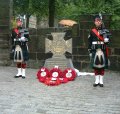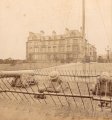|
 |
|
| |
 |
|  |
|
Details:
|
|
|
Sculptor:
J & G Mossman
(fl. 1816-).
Location: Necropolis, Glasgow.
Date executed: 2007.
|
|


|
The Victoria Cross (VC) is Britain’s highest award for gallantry in battle. Instituted by Queen Victoria in January 1856 at the request of Prince Albert near the end of the Crimean War of 1854-6, the first VC’s were said to be cast from Russian guns captured during the war. The first investiture of the medal took place in Hyde Park, London, on Friday, 26th June 1857, when it was presented by the Queen to 62 of the 111 recipients of the award during the conflict. Since then, the medal has been awarded more than 1356 times to men and women who served in the British and commonwealth forces in subsequent colonial conflicts, two world wars and, more recently, Iraq and Afghanistan.
|



| |
The recently unveiled VC memorial commemorates the 150th anniversary of the award and the 29 winners of the medal who were from Glasgow, or who are buried within the city’s cemeteries. Erected by the city council at the suggestion of Tom Healy, a VC enthusiast, the memorial was inspired by Tom’s discovery that one of the first Crimean recipients of the medal, James McKechnie of the Scots Guards, was buried in an unmarked, pauper’s grave in the Necropolis.
Discovering a further three unmarked VC holders’ graves in the city, he approached the council with a proposal to commemorate all recipients who had a Glasgow connection. After this met with the council’s approval, Kenny Pollock Smith, of the city’s oldest firm’s of monumental sculptors,
J & G Mossman
, was commissioned to design and erect the memorial on the north side of Kirk Lane, on the approach to the Bridge of Sighs in the Necropolis. The monument's unveiling took place on Saturday, 1st September, 2007.
|



| |
Carved in polished grey granite, the memorial is an enlarged version of the cross from the original medal: a cross patée, with its famous lion, crown and inscription: For Valour, engraved and traced on its front in 24 carat gold leaf. The cross surmounts a rectangular pedestal bearing the monument's dedicatory inscription:
IN HONOUR OF THE GLASWEGIANS AWARDED / THE VICTORIA CROSS FOR VALOUR. / THIS MEMORIAL WAS ERECTED BY THE CITY COUNCIL ON BEHALF OF / THE CITIZENS OF GLASGOW / IN REMEMBRANCE AND WITH OUR GRATITUDE.
|


| |
The unveiling ceremony followed a memorial service in Glasgow Cathedral
attended by the city’s Lord Provost, the Roman Catholic Archbishop, representatives of the armed services, and relatives of the VC winners, and was conducted with all the martial pomp and solemnity appropriate to the occasion, with Honour guards and standard bearers from the RHF and British Legion providing the colour parties and escorts.
The service and unveiling were conducted by Rev Dr Laurence Whitley, the Cathedral’s Minister, and the function itself was performed by the Lord Provost, Robert Winter, whose act of uncovering the memorial was followed by the laying of wreaths from the city, the armed forces and veterans groups.
|


| |
After the sounding of the last post and the piping of the Flowers of the Forest, the ceremony was brought to a close and the assembled guests invited, in time honoured fashion, to join the Lord Provost for refreshments.
|

| |
Handsome and highly valuable and much sought after by collectors today, the design for the original Victoria Cross was greeted with less than enthusiasm by the press in Glasgow. After describing the first investiture, the Glasgow Herald gave its own negative opinion of the medal’s artistic merits on 1st July, 1857:
“We have forgotten the medal itself, or the cross, rather, for such it is. Would we could forget it! Never did we see such a dull, heavy, and tasteless affair. Nor do we suspect that if it was on sale in any town in England at a penny a piece, hardly a dozen would have been sold in a twelvemonth. There is a cross, and a lion, and a scroll or two worked up into the most shapeless mass that the size admits of. Valour must, and doubtless will, be still its own reward in this country, for the Victoria Cross is the shabbiest of all prizes”.
150 years later, the medal has become unforgettable precisely because of its distinctive shape, and especially for the stories of the courage and fortitude shown by those whose wearing of the medal confirms them as the bravest of the brave, and worthy of the country’s highest praise and gratitude. Amongst the guests at the ceremony were three women VC winners, who proudly wore their crosses to mark the occasion.
|

| |
The VC Memorial is not, however, the first instance of a sculptural representation of the medal in Glasgow, or the city’s first memorial to the Crimean War. Two other depictions of the medal were created in 1916 and 2004. These are, respectively, the scale reproduction of the medal on the pedestal of the Lord Roberts
memorial in Kelvingrove Park, and the monument to James Stokes in the Gorbals Burial Ground, which has a base carved in the shape of the medal.
|


| |
Glasgow’s first memorial to the Crimean War was a battery of three captured Russian guns which stood on the present site of the Lord Roberts Memorial. These were erected a few days after the first VC's were presented, in the first week of July 1857. Around the same time, the city acquired a further two Russian batteries, which were erected in Queen's Park and Alexandra Park. Now lost, the story of the guns is told in our companion piece to this article: Glasgow’s Crimean War Trophies.
|
|
Click on an image to enlarge it.
|
Click here to return to the TOP.
|
|
|
All images and biographies are our copyright and may not be reproduced
in any form whatsoever without our express permission.
|
|
|
|
|
For sculpture and architecture: we have over 300 biographies of sculptors and architects connected with Glasgow, Scotland.
|
|
| Copyright 2001-2025 glasgowsculpture.com. |
|
|
| |
|
 |
|

